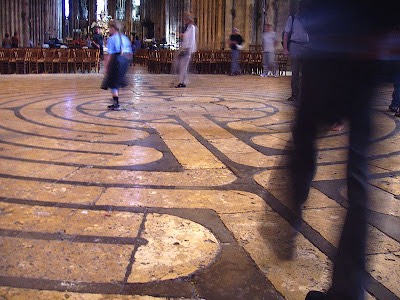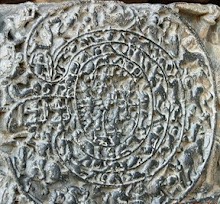Many prayer practices emerging in Christianity today are not of Christian origin but instead are ancient mystical rituals. One such ritual is labyrinth walking.
The first labyrinth was born out of the Greek myth of the Minotaur, a story filled with jealousy, murder, and bestiality. Labyrinths have been found in the art and architecture of civilizations throughout history and around the globe; the first labyrinth discovered was on a clay tablet in Pylos.

The Mystic Purpose of the Labyrinth
A labyrinth in Hoysaleswara, a Hindu temple dedicated to the god Shiva.
Within spiritual circles, the labyrinth is used as a tool for prayer. Roger Oakland explains:
The labyrinth is a maze-like structure that is growing in popularity, used during times of contemplative prayer. The participant walks throught this structure until he comes to the center, then back out again...Often prayer stations (with candles, icons, pictures, etc.) can be visited along the way. The labyrinth originated in early pagan societies. The usual scenario calls for the pray-er to do some sort of meditation practice, enabling him or her to center down (i.e., reach God's presence) while reaching the center of the labyrinth.i
Labyrinth walking is not a Christian practice, but a ritual enfolded into many world religions. According to President of the World Systems Research Group Carl Teichrib, "labyrinth walks and 'prayer journeys' are being promoted by Rosicrucian groups, at New Age festivals and celebrations, and throughout the neo-pagan world. Not surprisingly, one of America's largest witch, shaman, and neo-pagan assemblies, the 2005 Pagan Spirit Gathering at Wisteria, OH, held a night-time Summer Solstice Labyrinth ritual, which was described as a 'transformative, walking meditation through an all night labyrinth formed by 1000 lighted candles.'"ii
"Christian" Labyrinth Use
Despite the cross-religious and occult use of the labyrinth, it is still growing in popularity among Christians.Reverend Jill Geoffrion, a labyrinth facilitator, even supports the use of prayers from Hindu, Muslim, and Sanskrit traditions in labyrinth walking. She is author of several books on labyrinth walking, and writes this inChristian Prayer and Labyrinths:
We are currently in a period of historic labyrinth revival. Churches, retreat centers and Christian camps are placing these prayer tools inside and outside. Christians all over the world are installing labyrinths in their yards and gardens. Many are using the labyrinths as a ministry tool, bringing portable versions to prisons, national denominational conferences and church group meetings. It is conservatively estimated that there are over 5,000 labyrinths in the United States alone. God is blessing the use of the labyrinth; many are being drawn closer to Jesus, experiencing healing and gaining spiritual clarity as they pray on its path.ii
Dr. Lauren Artress, an American labyrinth supporter and Episcopal priest, has "lectured on it as a walking meditation, a path of prayer and a dynamic tool of manifestation. Her writing shows that modern labyrinth prayer is merely occult spiritualism in Christian garb:
The labyrinth is a large, complex spiral circle which is an ancient symbol for the divine mother, the God within, the goddess, the holy in all creation... a spiritual tool meant to awaken us to the deep rhythm that unites us to ourselves and to the Light that calls from within.iv
[The labyrinth is] truly a tool for transformation, a crucible for change, a blueprint for the sacred meeting of the psyche and the soul, a field of light, a cosmic dance, it is a center for empowering ritual.v
You walk to the center of the labyrinth and there at the center, you meet the Divine.
New York Times reporter Natalie Angier describes labyrinth walking as "a ceremony that is at once ancient and New Age mysticism. If the secular media can make these connections, how much more aware should evangelical Christians be of the dangers associated with labyrinth prayer?
Ahead to Spiritual Direction
i. Roger Oakland, Faith Undone (Oregon: Lighthouse Trails Publishing, 2007): 67.
ii. Rev. Jill K. H. Geoffrion, Christian Prayer and Labyrinths: Pathways to Faith, Hope and Love (Cincinnati: Pilgrim Press, 2004).
iii. LaurenArtress.com
iv. Dr. Lauren Artress, Walking A Sacred Path: Rediscovering the Labyrinth as a Spiritual Practice (New York: Berkeley Publishing Group, 2004).
v. Ibid.
vi. Lauren Artress, “Q and A with Lauren,” Veriditas 2 (Summer 1996): 18.
vii. Natalie Angier, "A Twisting Walk to Inner Peace on a Painted Purple Canvas, The New York Times (August 29, 1992).
Ahead to Spiritual Direction
